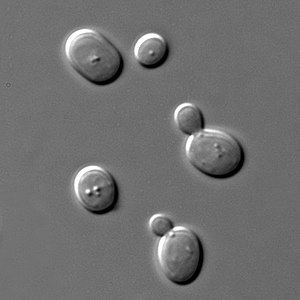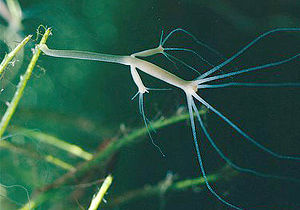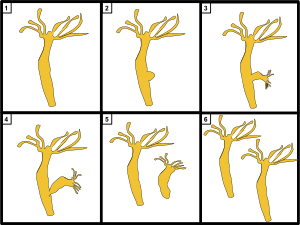Budding
Budding or blastogenesis is a type of asexual reproduction in which a new organism develops from an outgrowth or bud due to cell division at one particular site.
This article needs additional citations for verification. (March 2018) |
For example, the small bulb-like projection coming out from the yeast cell is known as a bud. Since the reproduction is asexual, the newly created organism is a clone and excepting mutations is genetically identical to the parent organism. Organisms such as hydra use regenerative cells for reproduction in the process of budding.

In hydra, a bud develops as an outgrowth due to repeated cell division at one specific site. These buds develop into tiny individuals and, when fully mature, detach from the parent body and become new independent individuals.
Internal budding or endodyogeny is a process of asexual reproduction, favored by parasites such as Toxoplasma gondii. It involves an unusual process in which two daughter cells are produced inside a mother cell, which is then consumed by the offspring prior to their separation.
Endopolygeny is the division into several organisms at once by internal budding.
Cellular reproduction
Some cells divide asymmetrically by budding, for example Saccharomyces cerevisiae, the yeast species used in baking and brewing. This process results in a 'mother' cell and a smaller 'daughter' cell. Cryo-electron tomography recently revealed that mitochondria in cells divide by budding.
Animal reproduction


In some multicellular animals, offspring may develop as outgrowths of the mother. Animals that reproduce by budding include corals, some sponges, some acoels (e.g., Convolutriloba), echinoderm larvae, placozoans, symbions, pterobranchians, entoproctans, some polychaetes, bryozoans, tunicates, flatworms and a single phoronid species.
Colony division
Colonies of some bee species have also exhibited budding behavior, such as Apis dorsata. Although budding behavior is rare in this bee species, it has been observed when a group of workers leave the natal nest and construct a new nest usually near the natal one.
Virology
In virology, budding is a form of viral shedding by which enveloped viruses acquire their external envelope from the host cell membrane, which bulges outwards and encloses the virion.
Plant multiplication
In agriculture and horticulture, budding refers to grafting the bud of one plant onto another.
See also
References
This article uses material from the Wikipedia English article Budding, which is released under the Creative Commons Attribution-ShareAlike 3.0 license ("CC BY-SA 3.0"); additional terms may apply (view authors). Content is available under CC BY-SA 4.0 unless otherwise noted. Images, videos and audio are available under their respective licenses.
®Wikipedia is a registered trademark of the Wiki Foundation, Inc. Wiki English (DUHOCTRUNGQUOC.VN) is an independent company and has no affiliation with Wiki Foundation.